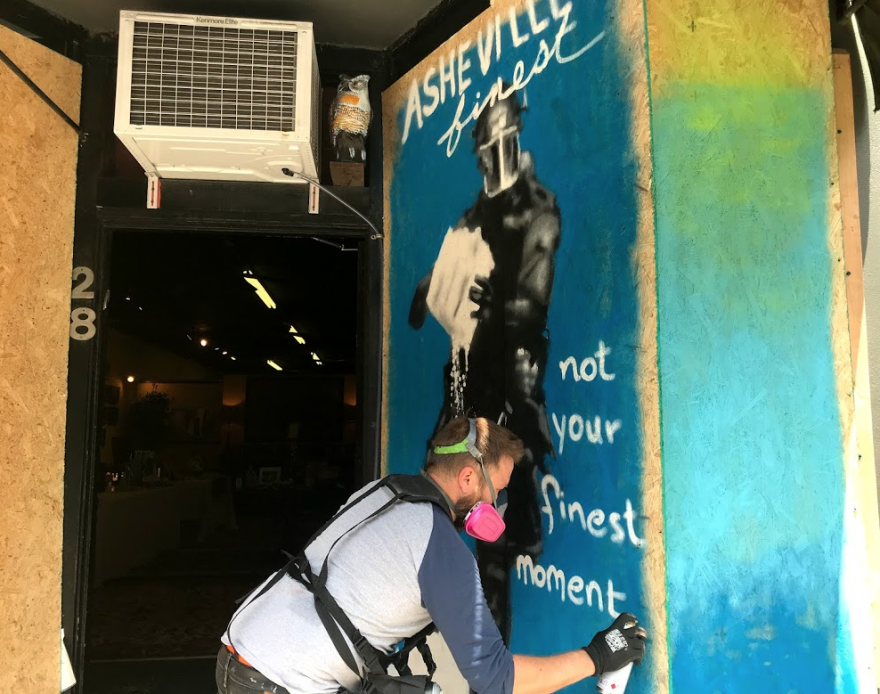Lexi DeYeso remembers the pride and passion she felt early this summer as Black Lives Matter protests unfolded in downtown Asheville.
“I do stand with the movement and peaceful protesting,” DeYeso said.
But when people disrupted the protests by smashing store windows, DeYeso’s boutique, Hazel Twenty, was among the first hit.
“I was screaming, I was shaking,” she recalled. “I was powerless and angry, really.”
Amid continuing protests, dozens of downtown businesses boarded up their windows, and several artists approached DeYeso and other store owners about dressing those boards with murals.
The paintings are homages to George Floyd, the Black Lives Matter movement and to larger issues of racial justice and equity, and they document a moment in this city’s and country’s history. Blue Ridge Public Radio commissioned Asheville artist Joseph Pearson to make art on the plywood that covered our offices.
But as the protests quieted, all but a few of the murals have come down. The question now: What should happen with them? For now, most are stored together in the basement of the Downtown Association. More permanent homes and plans for exhibiting them are complex.
It’s not only a question of ownership—the word itself is fraught with tension—but also one of agency. While the murals comment on injustices most acutely felt by Black Americans, they were for the most part painted by white artists inspired to volunteer their efforts.
“This is a very complicated and complex matter, and it always has been when it comes to race,” said Cleaster Cotton, a Black Asheville artist whose mural of bronze, cubist steel figures is on an outside wall of a Market Street condominium. She’s not involved with the plywood protest murals, but said it’s vital to digitally document them and eventually exhibit them, virtually and in the three-dimensional world.
“Let the Black artists and the white artists decide on what they want to do with the art and how they want to proceed,” Cotton said. “These pieces of art represent an unprecedented time in American history. They should be valued as such.”
DeWayne Barton is a Black Asheville native and artist who said he would like at least one of the murals for his Burton Street Community Peace Gardens.
“I’ve got a particular area in the garden that talks about police and shootings,” Barton said. “I’m gonna use it for a long-term educational tool, to continue to educate us about our errors and then what can we do to try to adjust it.”

Some have mentioned the Asheville Art Museum as a potential destination, for its experience collecting, maintaining and exhibiting fine artworks. But critics of that idea cite the museum’s long history of white leadership.
Katie Cornell is the executive director of the Asheville Area Arts Council and chair of the city’s Public Art and Cultural Commission. She said there’s talk among the artists who spearheaded the murals about auctioning them off and donating the proceeds to Black-run nonprofit organizations.
“It’s incredibly generous and wonderful that all of these artists came together and wanted their work to be used to raise funds for the Black community,” Cornell said. “But members of the Black community need to have a say in how it’s invested, but then who do you talk to? Who are those people that get to decide? I think in this case, it falls to the artists that led the movement.”
DeYeso said she and other store owners discussed this very question after the murals came down from their windows. She said she’d like the answers to come from a racial equality committee.
“Whose decision does it get to be, right?” she asked. “Is it the white business owner that had this mural up? Is it her responsibility to figure out where these go? No, but I think we want to be part of the conversation. We want this to happen. We don’t just want them sitting and collecting dust. I feel like it needs to be from our Black community in town who really determines what is the best use of these works of art.”
“Whatever creatively can be done with them, open it up,” Barton said. “Race don’t have anything to do with it. It’s the energy and spirit of the person sitting down or even coming up in their hearts and minds to even do something like that. Art is freedom—all day, every day.”






